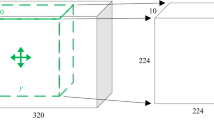Abstract
Human motion detection based on smartphone sensors has gained popularity for identifying everyday activities and enhancing situational awareness in pervasive and ubiquitous computing research. Modern machine learning and deep learning classifiers have been demonstrated on benchmark datasets to interpret people’s behaviors, including driving activities. While driving, driver behavior recognition may assist in activating accident detection. In this paper, we investigate driving behavior detection using deep learning techniques and smartphone sensors. We proposed the DriveNeXt classifier, which employs convolutional layers to extract spatial information and multi-branch aggregation transformation. This research evaluated the proposed model using a publicly available benchmark dataset that captures four activities: a driver entering/exiting and sitting/standing out of a vehicle. Classifier performance was evaluated using two common HAR indicators (accuracy and F1-score). The recommended DriveNeXt outperforms previous baseline deep learning models with the most fantastic accuracy of 96.95% and the highest F1-score of 96.82%, as shown by many investigations.
Access this chapter
Tax calculation will be finalised at checkout
Purchases are for personal use only
Similar content being viewed by others
References
Bevilacqua, A., MacDonald, K., Rangarej, A., Widjaya, V., Caulfield, B., Kechadi, T.: Human activity recognition with convolutional neural networks. In: Brefeld, U., et al. (eds.) ECML PKDD 2018. LNCS (LNAI), vol. 11053, pp. 541–552. Springer, Cham (2019). https://doi.org/10.1007/978-3-030-10997-4_33
Gil-Martín, M., San-Segundo, R., Fernández-Martínez, F., Ferreiros-López, J.: Time analysis in human activity recognition. Neural Process. Lett. 53(6), 4507–4525 (2021). https://doi.org/10.1007/s11063-021-10611-w
Hirawat, A.: Driver entry into and exit from a car using smartphone sensors. https://data.mendeley.com/datasets/3czshz7zpr/1, https://doi.org/10.17632/3czshz7zpr.1. Accessed 01 July 2022
Hirawat, A., Bhargava, D.: Enhanced accident detection system using safety application for emergency in mobile environment: SafeMe. In: Das, K.N., Deep, K., Pant, M., Bansal, J.C., Nagar, A. (eds.) Proceedings of Fourth International Conference on Soft Computing for Problem Solving. AISC, vol. 336, pp. 177–183. Springer, New Delhi (2015). https://doi.org/10.1007/978-81-322-2220-0_14
Hnoohom, N., Mekruksavanich, S., Jitpattanakul, A.: An efficient resnetse architecture for smoking activity recognition from smartwatch. Intell. Autom. Soft Comput. 35(1), 1245–1259 (2023). https://doi.org/10.32604/iasc.2023.028290
Ismail Fawaz, H., et al.: InceptionTime: finding AlexNet for time series classification. Data Min. Knowl. Discov. 34(6), 1936–1962 (2020). https://doi.org/10.1007/s10618-020-00710-y
Lawal, I.A., Bano, S.: Deep human activity recognition using wearable sensors. In: Proceedings of the 12th ACM International Conference on PErvasive Technologies Related to Assistive Environments, PETRA 2019, pp. 45–48. Association for Computing Machinery, New York (2019). https://doi.org/10.1145/3316782.3321538
Mekruksavanich, S., Hnoohom, N., Jitpattanakul, A.: A hybrid deep residual network for efficient transitional activity recognition based on wearable sensors. Appl. Sci. 12(10), 4988 (2022). https://doi.org/10.3390/app12104988
Mekruksavanich, S., Jitpattanakul, A.: Deep learning approaches for continuous authentication based on activity patterns using mobile sensing. Sensors 21(22), 7519 (2021). https://doi.org/10.3390/s21227519
Mekruksavanich, S., Jitpattanakul, A.: Multimodal wearable sensing for sport-related activity recognition using deep learning networks. J. Adv. Inf. Technol. 13(2), 132–138 (2022). https://doi.org/10.12720/jait.13.2.132-138
Mekruksavanich, S., Jitpattanakul, A.: Sport-related activity recognition from wearable sensors using bidirectional GRU network. Intell. Autom. Soft Comput. 34(3), 1907–1925 (2022). https://doi.org/10.32604/iasc.2022.027233
Mekruksavanich, S., Jitpattanakul, A., Sitthithakerngkiet, K., Youplao, P., Yupapin, P.: ResNet-SE: channel attention-based deep residual network for complex activity recognition using wrist-worn wearable sensors. IEEE Access 10, 51142–51154 (2022). https://doi.org/10.1109/ACCESS.2022.3174124
Noppitak, S., Surinta, O.: dropCyclic: snapshot ensemble convolutional neural network based on a new learning rate schedule for land use classification. IEEE Access 10, 60725–60737 (2022). https://doi.org/10.1109/ACCESS.2022.3180844
Sikder, N., Chowdhury, M.S., Arif, A.S.M., Nahid, A.A.: Human activity recognition using multichannel convolutional neural network. In: 2019 5th International Conference on Advances in Electrical Engineering (ICAEE), pp. 560–565 (2019). https://doi.org/10.1109/ICAEE48663.2019.8975649
Silla, C., Freitas, A.: A survey of hierarchical classification across different application domains. Data Min. Knowl. Disc. 22, 31–72 (2011). https://doi.org/10.1007/s10618-010-0175-9
White, J., Thompson, C., Turner, H., Dougherty, B., Schmidt, D.: WreckWatch: automatic traffic accident detection and notification with smartphones. Mob. Netw. Appl. 16, 285–303 (2011). https://doi.org/10.1007/s11036-011-0304-8
Xie, S., Girshick, R., Dollár, P., Tu, Z., He, K.: Aggregated residual transformations for deep neural networks. In: 2017 IEEE Conference on Computer Vision and Pattern Recognition (CVPR), pp. 5987–5995 (2017). https://doi.org/10.1109/CVPR.2017.634
Xu, W., Pang, Y., Yang, Y., Liu, Y.: Human activity recognition based on convolutional neural network. In: 2018 24th International Conference on Pattern Recognition (ICPR), pp. 165–170 (2018). https://doi.org/10.1109/ICPR.2018.8545435
Zehra, N., Azeem, S.H., Farhan, M.: Human activity recognition through ensemble learning of multiple convolutional neural networks. In: 2021 55th Annual Conference on Information Sciences and Systems (CISS), pp. 1–5 (2021). https://doi.org/10.1109/CISS50987.2021.9400290
Zhang, H., Xiao, Z., Wang, J., Li, F., Szczerbicki, E.: A novel IoT-perceptive human activity recognition (HAR) approach using multihead convolutional attention. IEEE Internet Things J. 7(2), 1072–1080 (2020). https://doi.org/10.1109/JIOT.2019.2949715
Zhu, R., et al.: Deep ensemble learning for human activity recognition using smartphone. In: 2018 IEEE 23rd International Conference on Digital Signal Processing (DSP), pp. 1–5 (2018). https://doi.org/10.1109/ICDSP.2018.8631677
Acknowledgment
This research project was supported by the Thailand Science Research and Innovation fund; the University of Phayao (Grant No. FF65-RIM041); National Science, Research and Innovation (NSRF); and King Mongkut’s University of Technology North Bangkok with Contract No. KMUTNB-FF-66-07.
The authors also gratefully acknowledge the support provided by Thammasat University Research fund under the TSRI, Contract No. TUFF19/2564 and TUFF24/2565, for the project of “AI Ready City Networking in RUN”, based on the RUN Digital Cluster collaboration scheme.
Author information
Authors and Affiliations
Corresponding author
Editor information
Editors and Affiliations
Rights and permissions
Copyright information
© 2022 The Author(s), under exclusive license to Springer Nature Switzerland AG
About this paper
Cite this paper
Mekruksavanich, S., Jantawong, P., Hnoohom, N., Jitpattanakul, A. (2022). Recognizing Driver Activities Using Deep Learning Approaches Based on Smartphone Sensors. In: Surinta, O., Kam Fung Yuen, K. (eds) Multi-disciplinary Trends in Artificial Intelligence. MIWAI 2022. Lecture Notes in Computer Science(), vol 13651. Springer, Cham. https://doi.org/10.1007/978-3-031-20992-5_13
Download citation
DOI: https://doi.org/10.1007/978-3-031-20992-5_13
Published:
Publisher Name: Springer, Cham
Print ISBN: 978-3-031-20991-8
Online ISBN: 978-3-031-20992-5
eBook Packages: Computer ScienceComputer Science (R0)




